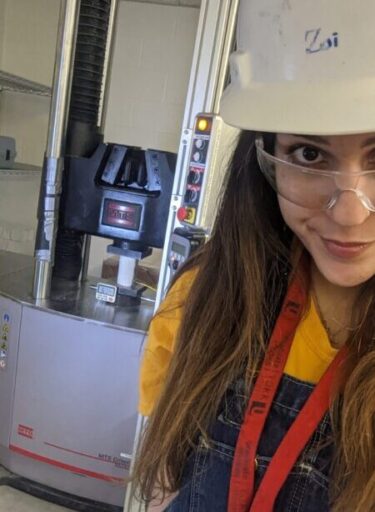Celebrating International Women in Engineering Day: Lassonde post-doctoral fellow pioneers eco-friendly concrete formula
Tags:

Each year, on June 23, International Women in Engineering Day honours the efforts and achievements of women while raising awareness of the need for diversification in the field. Lassonde School of Engineering at York University is committed to transforming the journeys of women in engineering, from experienced faculty members to budding student researchers with fresh ideas. Through community empowerment, women at Lassonde continue to lead solutions-driven work and advance the field of engineering – inspiring future generations to follow in their footsteps.
One example of a Lassonde researcher innovating in her field is Zoi Ralli, a postdoctoral fellow in the Civil Engineering department, supervised by Professor Stavroula Pantazopoulou. Summarized in a recent paper, Ralli developed and tested a novel, sustainable concrete which is formulated with recycled waste material in place of cement.
“Conventional concrete is the foundation of modern infrastructure and usually, the main component is cement,” says Ralli. “Cement production is a very energy intensive process, and it is responsible for seven percent of carbon dioxide emissions globally – for every tonne of cement, approximately one tonne of carbon dioxide is produced.”

Ralli’s cement-free concrete addresses the extreme sustainability concerns of traditional concrete production – boasting 70-90% reduction in carbon dioxide emissions. The material was developed with byproducts from a Canadian quarry, comprised of earth materials and minerals like silicon and aluminum. Using these byproducts as a binder and aggregate, Ralli developed a unique version of a material commonly referred to as geopolymer concrete.
“Geopolymer concrete is usually made by mixing powders that are rich in silicon and aluminum with alkaline liquid solutions. A very common aluminosilicate powder used in geopolymer concrete is fly ash, but there has been a major shortage of this waste material due to its environmental impact and Canada’s commitment to achieving net-zero carbon emissions by 2050,” she explains. “By formulating geopolymer concrete with quarry waste material, we wanted to explore and prove the effectiveness of alternative byproducts, while creating new opportunities for local quarry waste applications.”
Not only did Ralli successfully develop a sustainable concrete using unconventional materials, but she also designed the concrete with microfibers to improve overall strength and performance. These steel needle-like fibers allow the concrete to withstand harsh conditions, while minimizing cracking and increasing durability, among other favourable qualities.
“This work is about sharing an idea of using alternative binding materials and providing a foundation for future work in the field of sustainable and resilient building materials,” says Ralli. “Our paper shows that it is possible to completely eliminate the use of cement by replacing it with geological and industrial waste materials to develop a high-performance and sustainable concrete.”
Through her innovative research, Ralli continues to demonstrate the capabilities of women in engineering.
“As a woman in engineering, specializing in sustainable building materials, I have found empowerment through innovation and contributing toward sustainable infrastructure,” she says. “I aim to use my platform to inspire others by showcasing the transformative impact of diverse perspectives in forging sustainable solutions that mitigate climate change and build a greener future.”
Ralli’s work also contributes to the United Nations’ Sustainable Development Goals: 9, Industry, Innovation and Infrastructure, 11, Sustainable Cities and Communities and 13, Climate Action.
“Though my journey has been challenging, I am grateful that I had the opportunity to perform my research here at Lassonde. The School has supported me with securing funding for research projects on sustainable materials, and none of my achievements would have been possible without the unwavering support of my supervisor, Professor Pantazopoulou. She continues to ensure that I am equipped with everything I need to succeed.”
Learn more about Ralli’s trailblazing research in celebration of International Women in Engineering Day